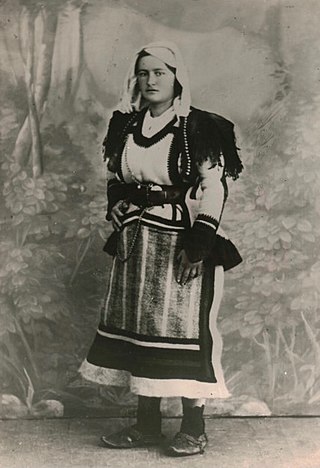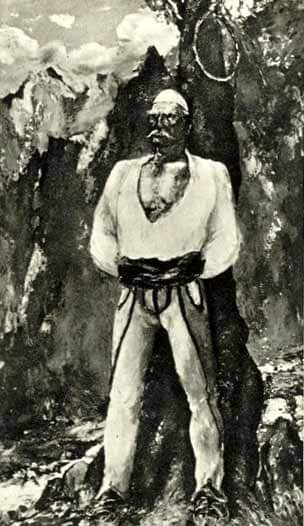Kadri Bajri (1823-1913) was an Albanian commander of the Albanian League of Prizren from Rugova.
Contents
Kadri Bajri | |
|---|---|
 | |
| Born | 1823 |
| Died | 1913 |
| Nationality | Albanian |
| Family | Bajri |
Kadri Bajri (1823-1913) was an Albanian commander of the Albanian League of Prizren from Rugova.
Kadri Bajri | |
|---|---|
 | |
| Born | 1823 |
| Died | 1913 |
| Nationality | Albanian |
| Family | Bajri |
Kadri Bajri was born in 1823 Koshutan, Rugova, Ottoman Empire, modern day Kosovo. Kadri Bajri was one of the leaders of the Albanian uprisings from Koshutan in Rugova. [1] He was a commander for the League of Prizren in the Battles for Plav and Gusinje, [2] where he arrived with 300 men from Rugova. [3]
There are many folk songs about Kadri Bajri in Albanian, [4] [5] [6] such as:

Kachaks is a term used for the Albanian rebels active in the late 19th and early 20th century in northern Albania, Montenegro, Kosovo and Macedonia, and later as a term for the militias of Albanian revolutionary organizations against the Kingdom of Serbia (1910–18) Kingdom of Yugoslavia (1918–24), called the "Kachak Movement".

Gollak or Gallap is a mountainous and ethnographic region in the eastern part of Kosovo and partially in Serbia, bordering the Llap region to the North, the Kosovo field to the west, the Anamorava valley to the south and straddling along the border with Serbia. The cities of Prishtina and Gjilan in Kosovo are located by the mountains. The highest peak, Gollak-Lisica, has an elevation of 1,186 m (3,891 ft) above sea level. Gollak itself is split into Upper Gollak and Lower Gollak.

Tringë Smajl Martini Ivezaj , known simply as Tringe Smajli, and as Yanitza outside Albania, was an Albanian guerrilla fighter who fought against the Ottoman Empire in the Malësia region. She was the daughter of Smajl Martini, a Catholic clan leader of the Grudë tribe of Malësia.

A xhamadan or xhamadani is a traditional wool garment worn by Albanian men. It can be sleeved or sleeveless. The sleeveless xhamadan is only one type of the Albanian vest, the other two being the xhamadani me reshme, and the xhamadani fermele. The xhamadani me reshme went out of use around the beginning of the 20th century. whereas the xhamadan and the xhamadani fermele continue to be used in traditional festivities. A good xhamadan is usually richly embroidered, sometimes in gold: in the past its quality revealed social rank.
Opinga are traditional shoes worn by Albanians in Albania, Kosovo, North Macedonia (opinci), Montenegro, Greece, and the Arbëresh villages of Italy. They were also worn by countrymen in Romania (opinca), Serbia, Croatia, Bosnia and Herzegovina (opanak), Bulgaria (opinka), and other countries. They are made of a single leather skin, formed to the feet with leather or wool strips. A southern Albanian variety of opinga are the typical turned up leather shoes with red and black wool pompoms on the ends, which are often used for folk dances.
Nicholas Dukagjini was a 15th-century member of the Dukagjini family.

Aqif Pasha Biçaku mostly known as Aqif Pashë Elbasani was an Ottoman Albanian political figure in the Sanjak of Elbasan and after the Young Turk Revolution became an activist for the Albanian national cause.

Zhuj Selmani was an Albanian partisan and an early proponent of the Albanian National Awakening. He was one of the leaders of the Albanian resistance against the Kingdom of Montenegro. At the beginning of the Great Eastern Crisis Albanians responded with armed resistance. Zhuj Selmani fought from his tower house (kulla) known as the tower of Sheremeti. Surrounded by Montenegrin forces in his tower, he blew it up, killing himself and many of the enemy soldiers.

Sali Jaha was an Albanian soldier and resistance fighter within the League of Prizren in Kosovo during the 19th century.

Sefë Mahmut Kosharja, also known as Sefë Qorri, was an Albanian resistance fighter and leader during the Albanian National Awakening, serving as a prominent member of the League of Prizren.
Çelë Shabani was an Albanian commander of the Albanian forces of the League of Prizren in 1879. Born and raised in Rugova, Shabani fought along Jakup Ferri in the Battle of Novšiće against the Montenegrin annexation of Plav-Gusinje area in 1879. He was a Malësor. As a young boy, he lived in Niksic and fought a Montenegrin named Uros. He came out as victorious and, as were the customs of the time, Shabani cut the head of the soldier and carried it with him. At the age of 22, Shabani was given a medal for his heroic acts. Shabani fought all his life against the Montenegrin forces of Marko Miljanov and died in Novšiće in 1879.

Andromaqi Gjergji was an Albanian ethnologist who was a specialist in Albanian costumes and dress.
Stefanaq Pollo was an Albanian academic, professor and historian during Communist Albania.
Shpend Dragobia was an Albanian warrior during the pre-Albanian declaration of independence period and later. He was the son of Bali Arif Bisheva, a member of the League of Prizren and fighter during the Albanian uprising of 1845-1862 against the German-born Marshal Mehmed Ali Pasha. Shpend Dragobia grew up to be a patriotic figure known for his wisdom, character and bravery.
The Convention of Dibra was organized on November 1, 1878, in the city of Dibra, on the initiative of the Committee of the Albanian League for the two Dibras chaired by Iljaz Pasha Dibra. The convention adopted a resolution in the form of a memorandum, drafted by Abdyl Frashëri who participated as representative of the whole of Vilayet of Ioannina.
Zylyftar Poda, born Iljaz Poda and also known as Silihtar Boda, was an Albanian leader, who led several revolts against the Ottoman Empire.
The Second Assembly of Frashër was one of the regional assemblies organized by the League of Prizren. It was held in Frashër in June 1880. It was attended by representatives of settlements with Albanian population which administratively were part of the vilayets of Ioannina and Manastir. The assembly had as central goal addressing the risk of partition of lands with Albanian populations among neighbouring countries. Among other things, the participants agreed on a proposal to form a central national government which would be formed by the General Assembly of the League of Prizren.

Botushë is a village in the municipality of Gjakova, District of Gjakova, southwest Kosovo. It is located near the border with Albania and is part of the Highlands of Gjakova. It is inhabited exclusively by Albanians.
Gennaro Placco (1826-1896) was an Arbëresh poet who was a prominent activist of the Risorgimento.
The Battle at the Ržanica Bridge was a significant battle between Albanian tribesmen and Montenegrin forces during the Battles for Plav and Gusinje. The battle played a crucial role in preventing the annexation of the tribal lands of Gruda and Hoti by Montenegro.